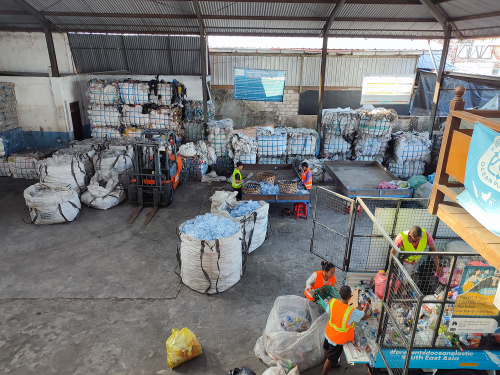
Across low- and middle-income countries (LMICs), the circular economy holds enormous promise for supporting countries to achieve the Sustainable Development Goals. Rethinking how products are designed, used, reused, and recycled can help reduce waste, lower emissions, and address biodiversity loss — all while generating local jobs and supporting a more resilient, sustainable, and inclusive growth model.
There has been growing momentum for pro-circular economy policies and investment globally, and DT Global has been supporting various countries with this through technical assistance to the Asian Development Bank-funded Promoting Actions on Plastic Pollution from Source to Sea in Southeast Asia and the Pacific programme. Examples include developing and supporting the implementation of city-level Plastic Management Action Plans in Manila (Philippines), Cirebon (Indonesia), and Tan An (Vietnam), and in Thailand, we have worked with the government to develop market mechanisms to strengthen the country’s recycling systems.
The growing global momentum has yielded results — but to really capitalise on this and accelerate progress, we need to generate and scale new innovations and solutions.
DT Global implements the FCDO-funded Frontier Tech Hub in a consortium with Brink and Results for Development (R4D). This programme pilots early-stage innovations and frontier technologies in LMICs. The Hub has piloted several early-stage circular economy innovations and recently embarked on a ‘deep dive’ into what helps or hinders early-stage circular innovations in LMICs.
You can access the full deep dive here, and this blog provides a summary of the report’s findings.
So, what determines success for early-stage circular economy innovations in LMICs? And how can donors, governments, and other development partners provide better support?

Access to finance is a major barrier for early-stage circular innovators. Compared to other sectors, circular solutions often face high upfront costs — especially for purchasing equipment or setting up production facilities. But because these innovations are still proving their models, they struggle to attract investment. Grant makers can be reluctant to fund capital expenditure for outcomes that are unknown.
Take the FT Hub’s Bioplastics pilot in Nepal, which aims to scale up bioplastics as a credible alternative to traditional plastics. Before even agreeing to a meeting, impact investors wanted to see proof of concept and extensive evidence of market demand. But how can innovations like this achieve proof of concept without obtaining funding for the equipment needed to prove their concept in the first place?
In the end, FT Hub support meant the team was able to build strong evidence of market demand. The team did this through market experiments — using a small amount of grant funding to subsidise the production of bioplastics products from India to sell to domestic customers — that tested price points and market demand. Positive market signs from this experiment gave the FT Hub the confidence to fund a medium-scale production facility (together with some match funding from One to Watch). The team recently met with potential investors to showcase their production facilities.
In addition, access to flexible grant funding is key and can be transformative for innovators. CIST Africa’s founder, who secured funding from the FT Hub’s COVID-19 response facility in 2021 to invest in commercial and international standard production capacity to scale up the production of hand sanitiser from water hyacinth (an invasive species), remarked that FT Hub funding “changed everything in our business” and allowed the organisation to access follow-on funding.
Many LMICs have begun to articulate national visions for the circular economy — and this can offer opportunities for early-stage innovators. However, there is often a gap between stated policy and implementation. For early-stage innovators, this means they cannot rely on pro-circular policy to drive success. In Nepal, the Bioplastics pilot implementers understood that the country’s plastic bag ban would not be enough to propel demand for their plastic alternative. Because the plastic bag ban lacks enforcement, alternative plastic products like bioplastic must ensure they are price-competitive with traditional plastic products.

Partnerships can play a critical role in helping early-stage circular economy innovators build revenue potential, gain technical or commercial expertise, and access markets. These partnerships take many forms — from joining accelerator programmes, to working with large businesses aiming to decarbonise supply chains or strengthen plastic sustainability credentials. Government partnerships can often accelerate access to networks, technical support, or opportunities for scale.
Funders should recognise the value of partnerships and support initiatives that have collaboration built in from the beginning — especially those that connect early-stage innovators to actors further along the value chain or in adjacent sectors.
For circular economy innovations to succeed commercially, they must offer a compelling value proposition. Relying on environmental or circular credentials alone is rarely sufficient, particularly in markets where price sensitivity is high and consumer awareness of environmental issues may be limited. Innovators must define and test their value proposition through user feedback, market analysis, or storytelling to improve their chances of success.
Circular solutions often create broader social and economic benefits, which innovators can and should highlight as part of their value proposition. In Malaysia, the FT Hub is piloting the use of agricultural waste — specifically rice husks — to produce high-purity silica, a key input for global silicon manufacturing. The pilot has attracted support by emphasising both the strategic global value of the material and the potential for local job creation and economic development.
Supporting early-stage circular economy innovations in LMICs is essential to building more inclusive, resilient, and sustainable systems. The insights from this report highlight what makes these innovations succeed — and what still holds them back. To explore the full findings, including detailed recommendations for funders and innovators, we invite you to read the full report. We hope it sparks action, collaboration, and continued learning across the ecosystem.